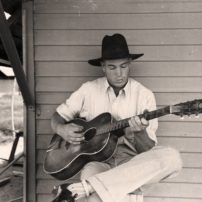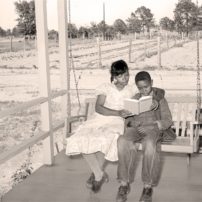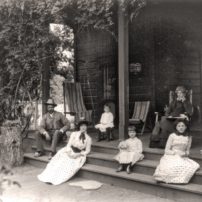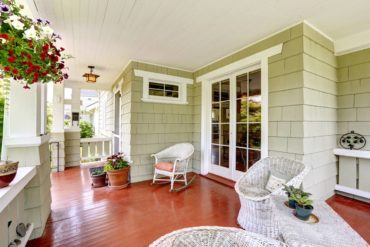 One of the best, most succinct explanations of the appeal of the American front porch comes from an Englishman — actor and editor Dan Stevens — who wrote in the online literary magazine The Junket: “The good ol’ American front porch seems to stand for positivity and openness; a platform from which to welcome or wave farewell; a place where things of significance could happen.”
One of the best, most succinct explanations of the appeal of the American front porch comes from an Englishman — actor and editor Dan Stevens — who wrote in the online literary magazine The Junket: “The good ol’ American front porch seems to stand for positivity and openness; a platform from which to welcome or wave farewell; a place where things of significance could happen.”
For more than a century, the American front porch was indeed a place where “things of significance” happened. It was, the University of Virginia reported in a cultural study, “an outdoor living room where the family could retire after the activities of a long day.”
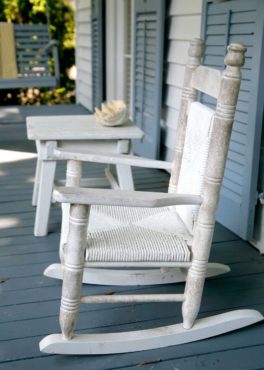 “In the evenings, as the outdoor air provided a cool alternative to the stuffy indoor temperatures, the entire family would move to the front porch,” the study reported.
“In the evenings, as the outdoor air provided a cool alternative to the stuffy indoor temperatures, the entire family would move to the front porch,” the study reported.
On the porch, one might enjoy a cool drink and shade on a warm day and take in the fragrance of the latest bloom in the garden, the serenade of birdsong and the buzzing of bees. It was “an area that could be shared between the sanctity of the home and the community outside,” the study said. “The neighbors from next door might stop by … The couple walking down the street might offer a passing ‘hello.’ … The porch brought the neighborhood and community together, by forcing interaction and an acute awareness of others.”
Sentimentalist Warren G. Harding, the nation’s 29th president, understood well what the porch symbolized in America and conducted much of his 1920 presidential campaign from the expansive porch of his Marion, Ohio, home. Thousands flocked to his home to hear him speak; one supporter carried a sign that read, “The Harding Front Porch is a Friendly, Neighborly Front Porch.” (Your local city council candidate who speaks from a host’s front porch during a meet-the-candidate event is continuing the political tradition.)
Then, the 1950s: Americans were drawn indoors by air conditioning and television. Or they got behind the wheel and went out. This was the Age of the Automobile. Why stay home when you could drive somewhere? By the 1960s, the front porch was no longer important and began disappearing from residential architecture.
The ‘Return’ of the Porch
Now, just as the Craftsman style emerged in response to the overly decorative Victorian era and the mass production of the industrial revolution, the American porch is returning in response to social and technological changes that disconnected people from nature and community.
In the time-starved, fast-paced, increasingly digital world, the porch is again a place where life slows down a little, allowing individuals to reconnect. “The children might play in the front yard or the friendly confines of the neighborhood,” while parents dismiss “the arduous labors and tasks of the day into relaxation and comfort,” the University of Virginia study stated. “Stories might be told, advice garnered, or songs sung. Whatever the traditions and manners of the family might be could be offered in this setting.”
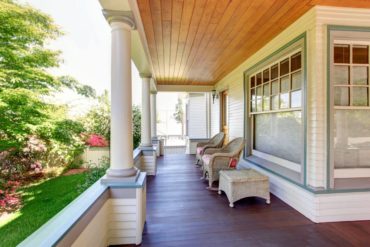 In several Kitsap County neighborhoods, the Craftsman ethic of connecting home to nature and people is a big part of the expansive front porches in Poulsbo’s Snowberry Bungalows neighborhood of Craftsman-style homes. Residents entertain on front porches that overlook gardens fragrant with rugosas or common spaces with fruit trees from which neighbors can harvest. Windows and porches provide views of the Olympics and neighboring evergreen forests.
In several Kitsap County neighborhoods, the Craftsman ethic of connecting home to nature and people is a big part of the expansive front porches in Poulsbo’s Snowberry Bungalows neighborhood of Craftsman-style homes. Residents entertain on front porches that overlook gardens fragrant with rugosas or common spaces with fruit trees from which neighbors can harvest. Windows and porches provide views of the Olympics and neighboring evergreen forests.
“If you’re out on your porch, you’re going to have visitors,” Snowberry Bungalows resident Krista Brooks said in an earlier WSHG interview. “That’s part of the appeal of this neighborhood. Most people are attracted to the concept of ‘neighborhood.’ This is like it was when I was a kid. It’s the kind of place where people leave the porch light on for you.”
Doug Woodside of Kingston, president of Decks and Patio Covers, specializes in exactly that — decks and covered patios. But in his work, he sees an increasing desire among homeowners to create outdoor living spaces as a place to connect with nature and people.
Woodside calls himself an “unplugged social media” specialist.
“Decks are ‘unplugged social media,'” he said. “The next time you are on a deck with family or friends, use this acronym, ‘DECKS,’ and think about what these unique spaces provide: discussion, entertainment, cooking, kidding, smiles.”
Front porches lack a suitable acronym, but Woodside said his “unplugged social media” thinking applies.
Essential Part of Community Life
Two prominent communities where the front porch is an essential part of community life are Seabrook, Washington; and Seaside, Florida. Homes in these planned ocean-front communities have expansive porches overlooking beaches, trees and green spaces where children play or ride bikes. Seaside’s developer wrote: “A front porch built on almost every cottage ensures you never meet a stranger.”
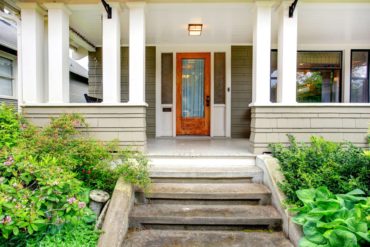 If you’re fascinated with front porches and have the time and resources, consider attending the third annual Conference on the Front Porch on Sept. 26-27 in Taylor, Mississippi (an 11-minute drive from Ole Miss). Conference attendees and speakers will explore the significance of the front porch, particularly in the American South, from an architectural and sociological perspective. The conference will explore “the origins of the front porch, its role in building and sustaining community, the porch and food, the porch and music, and the porch and its impact on the storytelling tradition in the South.”
If you’re fascinated with front porches and have the time and resources, consider attending the third annual Conference on the Front Porch on Sept. 26-27 in Taylor, Mississippi (an 11-minute drive from Ole Miss). Conference attendees and speakers will explore the significance of the front porch, particularly in the American South, from an architectural and sociological perspective. The conference will explore “the origins of the front porch, its role in building and sustaining community, the porch and food, the porch and music, and the porch and its impact on the storytelling tradition in the South.”
In writing about the conference, Marla Cantrell, managing editor of Do South magazine in Little Rock, Arkansas, wrote, “Most of us have memories of lingering on a front porch. Often, we were doing nothing more than sitting on a wide swing, making it move back and forth by pushing our toes against the wooden floor. But in those moments, a great deal was going on. We were letting our minds fill with creative thoughts, connecting with the place we called home.”
Front Porch Tips
No porch? No problem. A porch addition with a gently sloping shed roof can add character to and increase the footprint of a smaller home or a midcentury house that lacks a porch.
“It’s pretty easy to do,” said Holbein of Holbein Fine Carpentry and Design on Bainbridge Island, “But it has to be integrated well into the design, so it doesn’t detract from the rest of the house.” (He also has an architecture degree from California Polytechnic University in San Luis Obispo.)
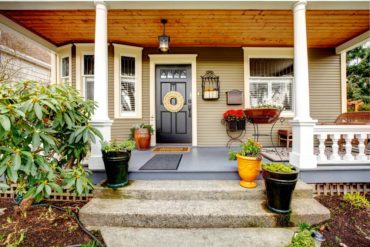 Woodside has made outdoor living spaces that blend with the architecture of homes built as early as 1907, a task made easier by materials that reflect the period of the home. Nature Kast makes weatherproof, tongue-and-groove, nutmeg ceiling planks that add a Craftsman-era feel, as well as weatherproof outdoor cabinetry in styles ranging from Mission to Shaker. Weatherproof wicker furniture can also add a classic look to an outdoor living space. Visit an architectural salvage company for vintage corbels, doors, pediments, pillars, posts and railings.
Woodside has made outdoor living spaces that blend with the architecture of homes built as early as 1907, a task made easier by materials that reflect the period of the home. Nature Kast makes weatherproof, tongue-and-groove, nutmeg ceiling planks that add a Craftsman-era feel, as well as weatherproof outdoor cabinetry in styles ranging from Mission to Shaker. Weatherproof wicker furniture can also add a classic look to an outdoor living space. Visit an architectural salvage company for vintage corbels, doors, pediments, pillars, posts and railings.
Woodside said there are a lot of great ideas on Houzz and Pinterest. “There are so many options today,” he said. “The sky’s the limit.”
Is your porch small? Laura Gaskill shared these space-maximization tips on the website Houzz:
- Choose a color scheme. “Use the color of your front door or trim as a jumping-off point,” Gaskill wrote. Repeat the same hue or hues in your porch accents, such as doormat, outdoor rug and flowerpots.
- The size of your pots should suit the size of your porch. On a smaller porch, “try a tall, narrow pot or a small planter box,” Gaskill advised.
- Adorn your porch with seasonal flowers in a window box or pot, or with a vase of freshly cut flowers.
- If you don’t have room for a pair of chairs with a side table in between, a steel garden stool with lid or an outdoor accent stool can do double duty as an extra seat or table.
Whether there’s room for a single chair and side table or a porch swing for two, America’s outdoor living room is back. Unplug and enjoy.
Richard Walker is a journalist and merchant mariner. He served as editor of the North Kitsap Herald and, later, of Kitsap News Group, from 2011 to 2018. “Point No Point” (Arcadia Publishing, May 2019) is his fourth book.





